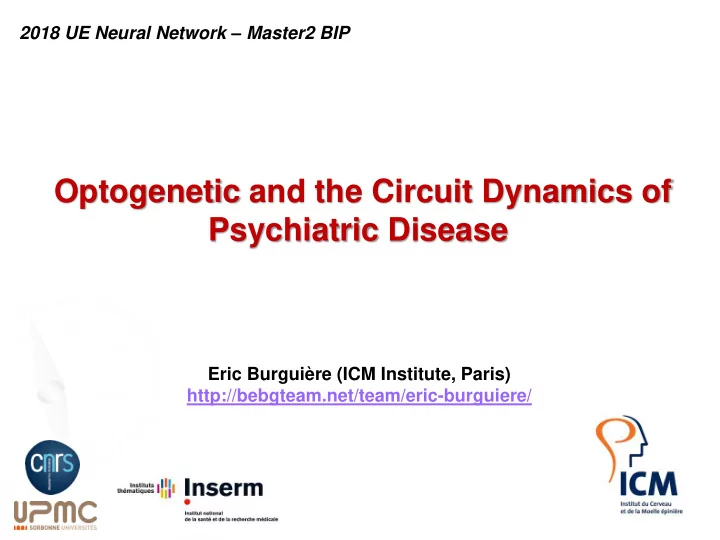

2018 UE Neural Network – Master2 BIP Optogenetic and the Circuit Dynamics of Psychiatric Disease Eric Burguière (ICM Institute, Paris) http://bebgteam.net/team/eric-burguiere/
Psychiatric Diseases Symptoms Quantitative Behaviors Animal Models
Psychiatric Diseases Obsessive Compulsive Disorders Symptoms Obsessions + Compulsions Quantitative Behaviors Compulsive Behaviors Mouse model of OCD Animal Models (SAPAP3-KO)
Methodological Approaches Behaviors
Methodological Approaches Behaviors Electrophysiology ?
Methodological Approaches Behaviors Electrophysiology Optogenetic K+ Opsine Na+ Cl-
Translational Approach Behavior Electrophysiology Therapy
What is the optogenetic technology?
Chlamydomonas reinhardtii
Channelrhodopsin (ChR2) Activation du cycle cellulaire
Virus
https://www.youtube.com/watch?v=v7uRFVR9BPU
1st part: Optogenetic: Basic concepts and methodology
Optogenetic approach allows to manipulate neural activity with great: 1) Spatial and cellular specificity 2) Temporal specificity
3 pillars for spatial specificity: - Expression pattern of the opsin - Location of light delivery - Optical power
Genetic expression specificity (Aravanis et al, J Neural Eng , 2007)
Promoter specificity approach
Cre-Lox System Deniz Atasoy et al. J. Neurosci. 2008;28:7025-7030
Transgenic Mouse Lines
Injection of AAV-CamKII-Chr2 in OFC Striatum OFC OFC Striatum
(Tay K and Deisseroth K, Nature Reviews , 2012)
Light diffusion in brain tissue (Welch et al., Nature , 2007)
Local activation by laser stimulation (Burguiere et al., Science , 2013)
3 pillars for timing specificity: - Type of Opsins - Nature of the Light Source - Shutters
(Yizhar al., Nature , 2007)
Diode-pumped Solid-State (DPSS) Laser Plus: High power (interesting for compensating for poor coupling, doing beam splitting etc...) Minus: Price, Space occupancy, Temporal characteristics
Diode-pumped Solid-State (DPSS) Laser Problems: Not steady state before warming period Not reliable with TTL pulse
An alternative: Mechanical shutters …but noisy, specially at high frequency
Light-emitting diode (LED) Plus: Nearly linear electrical current to optical power output, Cheap, Easy to handle Minus: Power
Conventional LED architecture… ...but could be wireless (Iwai et al., Neurosci Res 2011 )
2 nd part: Deconstructing the circuitry of compulsive behaviors with an optogenetic approach
Psychiatric Diseases Obsessive Compulsive Disorders Symptoms Obsessions + Compulsions Quantitative Behaviors Compulsive Behaviors Mouse model of OCD Animal Models (SAPAP3-KO)
Mouse model of OCD SAPAP3-KO mice: Over-grooming behaviors Higher anxiety Postsynaptic scalfolding protein that participates to the neurotransmission of cortical inputs Welch et al., Nature , 2007
Methodological Approaches Behaviors Working Hypothesis Learning theories of human compulsive behavior suggest that repetitive behaviors can result from malfunction of a learning process leading to loss of the ability to repress sensorimotor associations.
X 50
Behaviour Burguière E, Monteiro P, Feng G, Graybiel, , Science, 2013
Which circuitry could be affected in this behavioural deficit? Dorso- Medial Striatum - Lateral OFC and Dorso-Medial Striatum lesions studies showed emergence of impulsive behaviors ( Eagle et al. 2008; Rogers et al., 2001; Winstanley et al., 2004 ) - Lateral OFC projects to Dorso-Medial Striatum ( Schilman et al., 2008)
Methodological Approaches Behaviors Electrophysiology ?
Extracellular Recording Setup
Hyperactivity in the striatum but not in the OFC
Methodological Approaches Behaviors Electrophysiology Optogenetic K+ Opsine Na+ Cl-
Optogenetic Stimulation of the OFC-Striatal Pathway - Injection of AAV-CamKII-Chr2 virus in lateral OFC - 3 weeks minimum of expression LFPs in OFC and Striatum OFC Striatum
Optogenetic Stimulation of the OFC-Striatal Pathway - Injection of AAV-CamKII-Chr2 virus in lateral OFC - 3 weeks minimum of expression LFPs in OFC and Striatum OFC Striatum
Optogenetic Stimulation of the OFC-Striatal Pathway - Injection of AAV-CamKII-Chr2 virus in lateral OFC - 3 weeks minimum of expression LFPs in OFC and Striatum OFC Striatum
Optogenetic Modulation of the striatal activity (Burguière et al. , Science, 2013)
PV-interneurons are reduced in SAPAP3-KO mouse MSN PV+ MSN PV+ MSN PV+ PV+ PV+ PV+ PV+ SAPAP3-KO Silberberg and Bolam, Curr Op Neurobio 2015 Burguière E, Monteiro P, Feng G, Graybiel, Science, 2013
Behavioral effects of OFC-striatal optogenetic stimulation
Behavioral effects of OFC-striatal optogenetic stimulation Laser Stimulation (5Hz, 5ms pulse, 5mW) in homecage 3min ON/3min OFF during 30 min
Repetitive Behaviors Burguière E, Monteiro P, Feng G and Graybiel, Curr Opin Neurobiol, 2015
Current questions Are the striatal PV-interneurons sufficient to reduce compulsive grooming ? Can we optimize temporal specificity for preventing compulsive events?
Practical example
Current questions Are the striatal PV-interneurons sufficient to reduce compulsive grooming ?
Creation of a new line of mice
Current questions Are the striatal PV-interneurons sufficient to reduce compulsive grooming ? Can we optimize temporal specificity for preventing compulsive events?
Lizbeth Mondragon Frequency (Hz) 250 Frequency (Hz) 250 60 60 15 15 4 4 1 1 Frequency (Hz) 250 Frequency (Hz) 250 60 60 15 15 4 4 1 1 Frequency (Hz) 250 Frequency (Hz) 250 60 60 15 15 4 4 1 1
Closed-loop stimulation BaseLine Closed- Yoked 2 min/bloc = 36 min Session: Loop x 4 times Prediction N predictions = N random stimulations Grooming time (in s) - @10mW 5ms 20 HZ 45,00 40,00 35,00 29,97 30,00 25,00 21,6 20,00 15,00 11,70 10,00 5,00 0,00 % Time grooming Baseline CL-On Joked (Error bars represent SEM, n=2, 6 Sessions, 36 min each)
Pathophysiology of Compulsive Disorders Subthalamic Nucleus
Pathophysiology of Compulsive Disorders What are the effects of Subthalamic electrical stimulation on the Nucleus neuronal circuitry?
What optogenetic approach could we use to mimic these 3 scenarii?
Inhibitory Opsine Excitatory Opsine
Some weblinks: Methodological and very informative http://www.openoptogenetics.org/index.php?title=Main_Page Optogenetic ressource centers (virus construct, opsins, etc.): http://web.stanford.edu/group/dlab/optogenetics/ http://www.syntheticneurobiology.org/protocols Nice tool to calculate irradiance of the light in the tissue: http://web.stanford.edu/group/dlab/cgi-bin/graph/chart.php
Recommend
More recommend